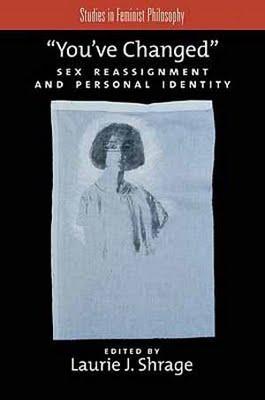You’ve Changed: Sex Reassignment and Personal Identity

Each essay in Laurie J. Shrage’s collection, You've Changed, takes on the challenge of analyzing the philosophical, cultural, and psychological dimensions of the—for lack of a better or more acute concept—umbrella category of “trans” identity. This same challenge, which underlines the collection’s creation, is the same challenge that often times handicaps its clarity and ultimate success. The breadth of scope of the volume on “trans” identities is awe-inspiring, but simultaneously hinders the conceptual clarity of many of the concepts discussed within the essays: “trans,” used primarily as an identity prefix, is applied indiscriminately, and, frequently inconsistently, to gender, sex, and sexuality throughout the essays. The difficulty, from the reader’s perspective, is the inability to grasp exactly, with precision, what—philosophical, phenomenological, or physical—concept the author is referring to in their his/her essay. Each author attempts to map out the concepts that they he/she engages with in their his/her essay, but the lack of conceptual consistency and coherence within each essay, and among the essays collectively, creates readerly confusion (for even the most adept of gender studies scholars!).
Take, for instance, the first essay of the volume, Christine Overall’s “Sex/Gender Transitions and Life-Changing Aspirations.” Overall logically begins the essay by laying out the terms of her discussion of transitioning. She writes, “I use the general term ‘trans’ to refer to individuals who go through changes from man to woman or woman to man, deliberately glossing over the differences among transgendered and transsexual individuals.” She then goes on to explain, that “gender is the presentation or identification (or both) of self as being a woman or a man or some permutation thereof. By ‘sex’, [she] mean[s] (human) female and male, as well as (human) femaleness and (human) maleness,” and delimits “femaleness” and “maleness” by “the presence of the genitalia standardly associated with each.” The first “gloss” is logically productive in that it allows Overall to employ “trans” to refer to any form of “transitioning” that an individual may experience in her life. However, the following clause, which seems an attempt at specification, only problematizes the concepts of gender and sex, which clouds the productive function of the “trans” prefix, and which is apparent by the author’s continual untangling of “gender” and “sex” throughout the essay.
Overall’s essay, like all essays in the volume, is praiseworthy for its sophisticated and serious effort. Gayle Salamon’s essay, “The Sexual Schema: Transposition and Transgender in Phenomenology of Perception,” is particularly brilliant for its appraisal of Merleau-Ponty’s text and how it manages to illustrate how Merleau-Ponty’s work in general—once shunned for being too “airy-fairy,” poetical, or qualitative—proves quite useful to discussions of trans identities.